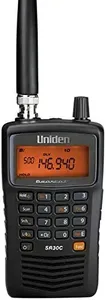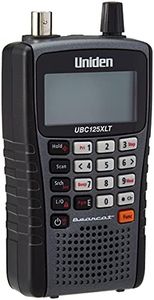We Use CookiesWe use cookies to enhance the security, performance,
functionality and for analytical and promotional activities. By continuing to browse this site you
are agreeing to our privacy policy
9 Best Radio Scanners
From leading brands and best sellers available on the web.By clicking on a link to a third party's website, log data is shared with that third party.
Buying Guide for the Best Radio Scanners
Choosing a radio scanner can be exciting as it opens up the world of listening to local emergency services, aviation, weather updates, and sometimes even amateur radio operators. To get the best experience, you'll want to focus on a few key specifications that determine what you can listen to, how easy the device is to use, and how portable it will be in your day-to-day life. Your listening interests and where you plan to use the scanner should be your guiding force during this process.Frequency CoverageFrequency coverage refers to the range of radio frequencies the scanner can pick up. This is crucial because different services (police, fire, weather, air, etc.) use different frequency ranges. Scanners may support just basic analog frequencies or also support digital and trunked radio systems used by many agencies today. If you only want to listen to common broadcasts like weather or aircraft, a simpler frequency range might work, but for listening to local emergency services, wider and more advanced frequency support is important. Always check what services operate in your area and choose a scanner that can receive those frequencies.
Analog vs. DigitalThis defines whether a scanner can listen to old-style analog signals, the newer digital signals, or both. Many modern emergency and public safety agencies have switched to digital radio, which requires a scanner capable of decoding these. If only analog signals are in use locally, a basic model will suffice. However, if digital signals are present (often labeled as P25 or DMR), you'll need a digital-compatible scanner. Determine which types are used in your region before picking.
Number of ChannelsChannels are individual slots or memories where you can store frequencies you want to monitor. More channels let you program more frequencies, making it easier to monitor multiple agencies or interests without having to reprogram constantly. For casual listening, fewer channels may be fine, but if you want to monitor several services at once or travel with your scanner, a higher channel count is convenient.
Trunking CapabilityTrunking is a system used by many organizations to share a set of frequencies dynamically – it makes radio use more efficient but is harder for basic scanners to track. If your local services use a trunked radio system, your scanner must specifically support trunking to tune in successfully. If trunking isn’t used in your area, this feature is less important.
Portability (Handheld vs. Desktop)Radio scanners come as portable handheld units or larger desktop/base units. Handheld models are battery-operated, smaller, and ideal for carrying around or for use in a car. Desktop models often have more powerful antennas and sometimes larger displays, making them better for stationary use in a home or office. Choose based on whether you'll be on the move or listening from one spot.
Ease of Use (Display and Controls)Ease of use includes how simple it is to program and operate the scanner. Features like a clear backlit display, intuitive buttons, and guidance for entering frequencies make day-to-day use easier. Some models include computer programming, which is helpful for more advanced users. If you’re just starting, look for something that advertises user-friendly menus and simple controls.
Audio QualityThe quality of the scanner’s speaker and headphone output matters for long-term comfort. A loud, clear sound helps in noisy environments or if you plan to listen for extended periods. If you’ll be scanning in noisy places, look for models known for good speaker volume and clarity.











